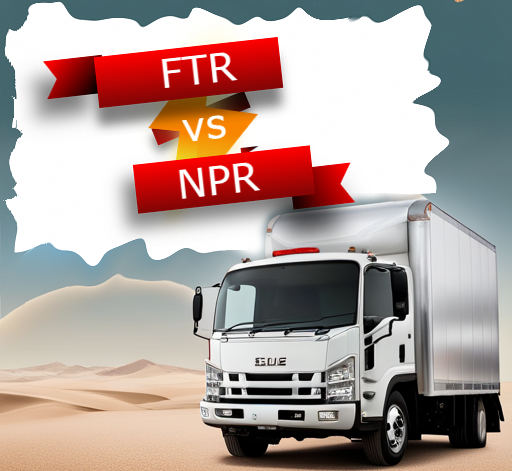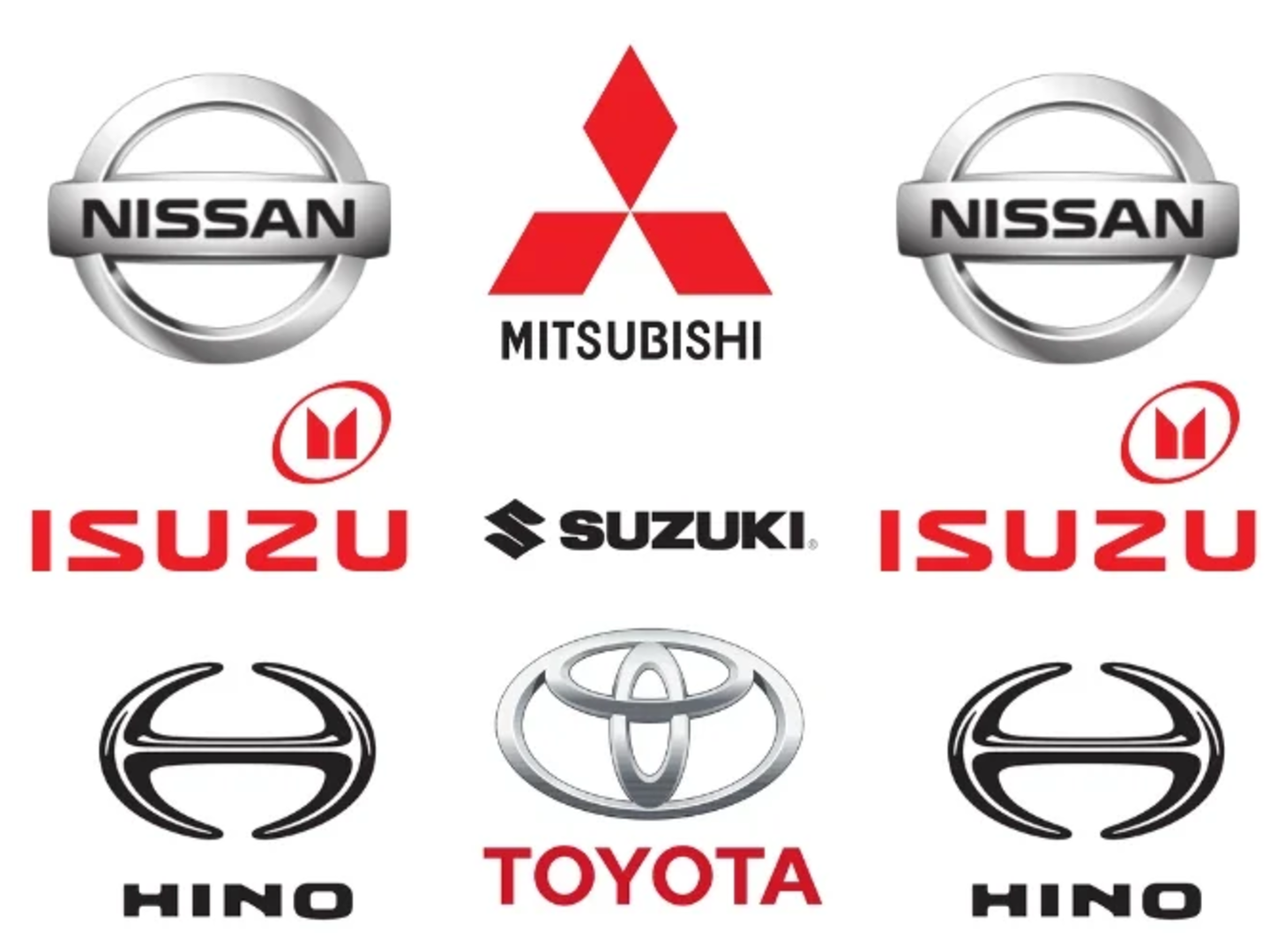Introduction
Isuzu, a renowned Japanese automaker, has been a prominent player in the commercial truck industry for decades. Among its many offerings, the Isuzu FTR and NPR stand out as popular choices for various business needs. While both trucks offer impressive performance and reliability, they cater to different segments of the market with different specifications in terms of performance, size, payload capacity and cab configurations.
In this blog post we have crafted an in-depth comparison exploring the key differences between the Isuzu FTR and NPR to help you make an informed decision when selecting the right commercial truck for your business.
Isuzu FTR vs NPR; Performance
| Feature | Isuzu FTR Diesel | Isuzu NPR-HD Diesel |
|---|---|---|
| GVWR | 25,950 lbs. | 14,500 lbs. |
| Engine type | Cummins B6.7 Liter Turbo Diesel 6-cyl. | 5.2 Liter Inline 4HK1-TC Isuzu 4-cyl |
| Horsepower | 260 HP @ 2,400 rpm | 215 HP @ 2,500 rpm |
| Torque | 660 lbs. ft. @ 1,600 rpm | 452 lbs. ft. @ 1,850 rpm |
| Transmission | Allison 2550 RDS 6-speed Double Overdrive | Aisin 6-Spd Double Overdrive |
| Steering | Power | Power |
| Front Axle Capacity | 12,000 lbs. Reverse Elliot “I”-beam | 6,830 lbs. |
| Front Suspension | 12,000 lbs. Semi-elliptical Leaf | 6,830 lbs. Tapered |
| Rear Axle Capacity | 19,000 lbs. Dana Single-speed | 11,020 lbs. |
| Rear Axle Ratio | 5.57 | 5.57 |
| Rear Suspension | 21,000 lbs. Multi-leaf / optional 23,000 lbs. Air Spring | 9,880 lbs. Multi Leaf |
| Front Brakes | 16.5″ x 5.0″ Drum | 11.5″ Disc |
| Rear Brakes | 16.5″ x 7.0″ Drum | 11.5″ Disc |
| Brake System | Full Air w/ABS | Electronic w/ABS |
| Wheels | 22.5″ x 8.25″ 10 Stud Steel or Aluminum Disc | 16″ x 6″ / 6 Bolt |
| Fuel Tank | 50 or 100 Gallon | 30 Gallon In-Frame |
| Def Tank | 10.0 Gallon | 4.2 Gallon |
| Wheelbase Option | 152″ / 170″ / 188″ / 200″ / 212″ / 224″ / 236″ / 248″ | 109″ / 132.5″ / 150″ / 176″ |
| Shortest Turning Radius | 43.7′ | 31.5′ |
| Body Lengths | 14′ – 30′ | 12′ – 20′ |
| Body / Payload Allowance | Up to 16,264 lbs. | Up to 8,511 lbs. |
FTR vs NPR; Interior Specifications
| Feature | Isuzu FTR Diesel | Isuzu NPR-HD Diesel |
|---|---|---|
| Specification | 2024 Isuzu FTR Diesel | 2024 Isuzu NPR-HD Diesel |
| Cab Style | Tilt Cab | Tilt Cab |
| Cab Type | Single | Single/crew |
| Door Entry | 90 Degrees | 85 Degrees |
| Seating | 3 Across | 3 Across |
| Seat Material | Tricot Fabric | Tricot Fabric |
| DOT Required Fire Extinguisher | Optional | Behind Seat |
| Folding Center Seat | Available | Available |
| Center Work Station | Available | Available |
| Cruise Control | Available | Available |
| Air Conditioning | Available | Available |
| Power Door Locks | Available | Available |
| Power Windows | Available | Available |
| Tilt Telescoping Wheel | Available | Available |
| AM/FM/CD Bluetooth Radio | Available | Available |
| Remote Heated Mirrors | Optional 2 Way | Optional |
Isuzu FTR vs Isuzu NPR; The Summary
Size and Payload Capacity
One of the most noticeable differences between the Isuzu FTR and NPR is their size and payload capacity. The FTR is a larger and more robust truck, designed for heavier loads. It typically comes in class 6 or 7, with a gross vehicle weight rating (GVWR) ranging from 25,950 to 33,000 pounds.
This makes it suitable for medium-duty and heavy-duty applications, such as delivery trucks, refrigerated transport, and construction.
On the other hand, the Isuzu NPR is a smaller and more compact truck, often classified as a class 4 or 5 vehicle. The NPR’s GVWR typically ranges from 12,000 to 14,500 pounds, making it ideal for light-duty and medium-duty tasks.
The lower payload capacity of the NPR is better suited for urban deliveries, landscaping, and other applications where maneuverability is key.
Engine Options
Both the Isuzu FTR and NPR offer a variety of engine options to suit different needs. The FTR is equipped with more powerful engines, often featuring Isuzu’s 5.2-liter 4HK1-TC turbocharged diesel engine. This engine provides greater torque and horsepower, making it well-suited for heavier loads and long-distance hauling.
In contrast, the Isuzu NPR usually comes with smaller, more fuel-efficient engines, such as the 5.2-liter 4HK1-TC diesel or a gasoline-powered 6.0-liter V8 engine. These engines are designed for shorter routes and urban environments, where fuel efficiency and emissions may be more critical considerations.
Cab Configuration
The cab configuration is another key difference between these two Isuzu models. The FTR often comes with a more spacious and comfortable crew cab, offering seating for up to seven people. This makes it suitable for applications where a larger crew is needed or for long-haul trips where driver comfort is crucial.
The NPR, on the other hand, typically features a standard or crew cab with a smaller passenger capacity. It is well-suited for applications where a smaller crew is sufficient, such as local deliveries, small business operations, or utility services.
Price
Due to the differences in size, capabilities, and features, there is a notable price discrepancy between the Isuzu FTR and NPR. The FTR, being a larger and more powerful truck, tends to come with a higher price tag. However, it offers better capabilities for handling heavy loads and long-distance transport.
The NPR, on the other hand, is generally more budget-friendly, making it a preferred choice for small businesses and local delivery operations where a lower upfront cost is a significant consideration.
Conclusion
When deciding between the Isuzu FTR and NPR, it’s crucial to consider the specific needs of your business. Based on these specs, if you require a heavy-duty workhorse for long-haul transportation or substantial payloads, the FTR is an excellent choice. On the other hand, if your business focuses on local deliveries, smaller payloads, and urban driving, the NPR’s versatility and cost-efficiency make it a practical selection.
You may also read,



